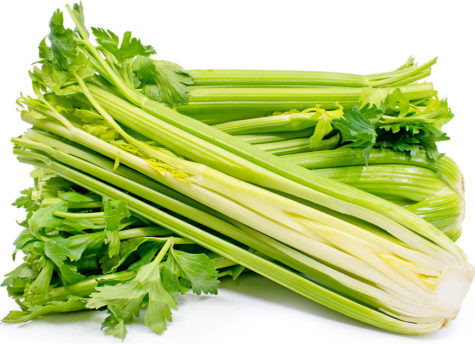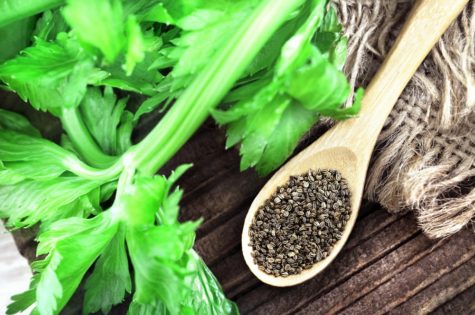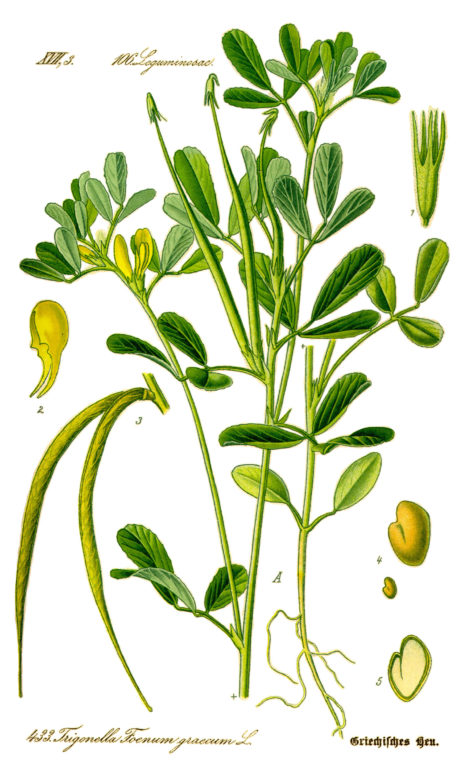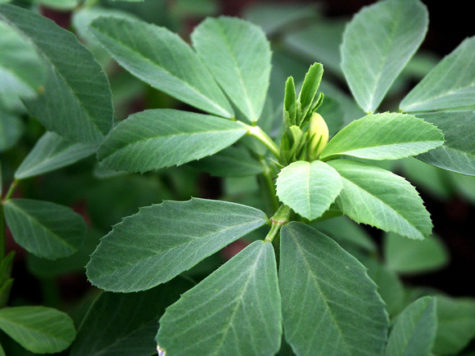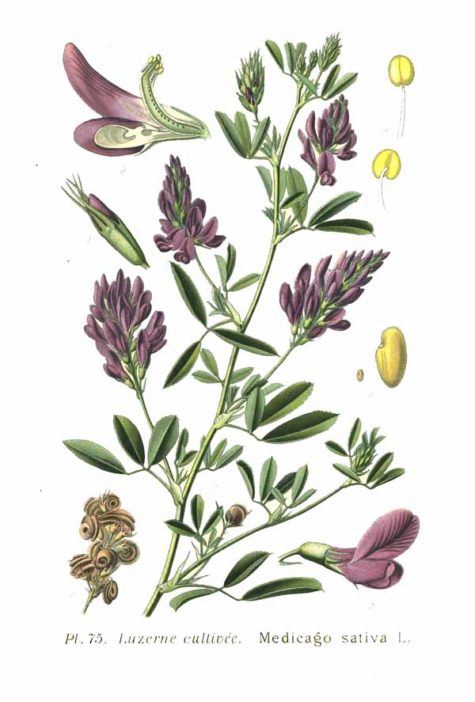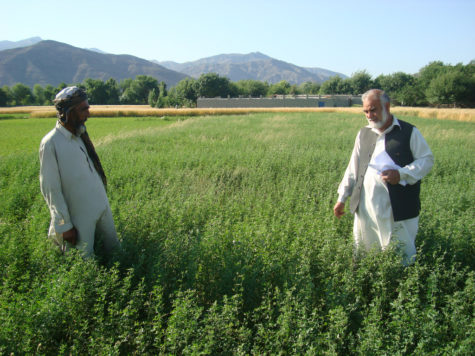Galactogogue
Celery
- Scientific Name: Apium graveolens var. dulce
- Plant Family: Umbelliferae
- Parts Used: Leaves, Stalks, Seeds, Roots
- Actions: Digestive, Stimulant, Diuretic, Anti-rheumatic, Carminative, Sedative, Aromatic
This is the cultivated celery, introduced into Britain in the late 17th century from Italy, replacing as a potherb the acrid little wild celery, known as “smallage,” that grows in salt marshes and river estuaries in Britain and Europe.
Some people use celery on the skin to repel mosquitoes. Some people also take celery by mouth for conditions such as menstrual cramps, prediabetes. Unblanched celery is rich in vitamins and mineral salts. It is a digestive and stimulant with a reputation for lowering blood pressure.
Celery seeds find their main use in the treatment of rheumatism, arthritis, and gout. They are especially useful in rheumatoid arthritis where there is an associated mental depression. Their diuretic action is obviously involved in rheumatic conditions, but they are also used as a urinary antiseptic, largely because of the volatile oil apiol.
Appearance
The leaves are smooth, shining, yellow-green and feathery, and the fleshy ridged stem is a bright green unless blanched pale. It is a biennial, umbels of white flowers appearing in late summer during the second year, followed by dark, ridged seeds.
Habitat and Cultivation
Celery thrives in cool, mild climates and requires high levels of moisture. Growing to a height of 15-24 inches, celery has long, fibrous petioles formed by conically arranged stalks joined at the base that surround the heart of the celery plant. The stalks each produce three to five bright green, pinnate leaves at the tip of the stalk.
Celery’s small white or yellow flowers appear in umbels from January to August during the plant’s second year of growth. The celery fruits, or schizocarps, consist of two united carpels (mericarps), each containing a brown, ridged, ovoid-shaped, very small seed, approximately 1.3 mm in length. These fruits, known in commerce as “celery seed,” have a floral odor and slightly pungent taste, and typically ripen in August and September.
Celery is cultivated worldwide. Celery’s Latin binomial, Apium graveolens, translates to “strongly smelling” and alludes to celery’s aromatic compounds.
Cultivated celery has been bred for its elongated, thick, fleshy, ribbed, milder-tasting stalks, while wild celery is grown for its bitter leaves. By the early 19th century, four varieties of celery were cultivated in the United States, where the plant gained popularity as a salad vegetable.
Three varieties of celery are the most commonly cultivated:
- Chinese celery (var. secalinum), which is used sparingly as a condiment due to its strong, bitter taste.
- Stalk celery (var. dulce), which is eaten raw in salads or cooked.
- Celeriac or “turnip-rooted celery” (var. rapaceum), which is grown for its enlarged root. Celeriac is popular in European cuisine and its seeds also are used for making commercial celery salt.
Medicinal Uses
Cooling thermal nature; sweet and bitter flavor, Celery benefits the stomach and spleen-pancreas and calms an aggravated liver. It improves digestion, dries damp excesses, purifies the blood, reduces wind conditions such as vertigo and nervousness, and promotes sweating.
Also used for heat excesses such as eye inflammations, burning urine, blood in the urine, acne, and canker sores. It will cool internal heat in the liver and stomach, which often contributes to headaches and excessive appetite, among other maladies.
For appetite control, raw celery can be eaten between and during meals. To slow down and encourage more thorough chewing of food, eat celery with a meal.
Celery is one of the few vegetables that combines well with fruit, as it has an ability to dry damp conditions, including those associated with eating fruit and concentrated sweeteners.
Celery juice combined with a little lemon juice is a remedy for the common cold when fever is more prominent than chills. The combination is helpful in headaches caused by high blood pressure or by heat conditions (red face, head feels hot, red tongue, and/or irritability).
Celery juice alone or in combination with lemon is useful for diabetes and helps clear the acidosis commonly caused by diabetes. For this purpose, drink 2 to 4 cups of the juice daily.
Very high in silicon, celery helps renew joints, bones, arteries, and all connective tissues. Because of these effects and the capacity of celery to clear digestive fermentation (dampness) and acidic blood that frequently accompany tissue inflammations, it is useful in the treatment of rheumatism, arthritis, gout, and nerve inflammations.
Both the stalks and roots are used in the East and West to treat high blood pressure and are a safe remedy for high blood pressure during pregnancy.
It is thought that the chemicals in celery can have many effects on the human body, including lowering blood pressure and blood sugar and causing sleepiness, but there is limited research to support these proposed effects. Chemicals in celery seem to reduce the ability of bacteria to cause urinary tract infections (UTIs).
Celery seeds, leaves, stem, and root are used in a variety of traditional medicine systems, including the Unani tradition of ancient Persia and Arabia, Indian Ayurveda, and Chinese herbal medicine. As an herbal preparation, celery seeds were consumed fresh or as a water decoction, or the seed powder or extracts were used. Continue reading
Fenugreek
- Scientific Name: Trigonella foenum-graecum
- Plant Family: Leguminosae
- Parts Used: Seeds
- Medical Actions: Expectorant, Demulcent, Tonic, Galactagogue, Emmenagogue, Emollient, Vulnerary
- Constituents: 30% mucilage, bitter principle, volatile and fixed oil, flavonoids, alkaloids, coumarins, vitamins, and saponins; the most prevalent alkaloid is trigonelline and coumarins include cinnamic acid and scopoletin.
The Basics
Originally from the eastern Mediterranean, cultivated in Europe, Africa and Asia for thousands of years as a fodder plant, a medicine, and a spice, Fenugreek is an herb that has an ancient history. It has great use in local healing and reducing inflammation for conditions such as wounds, boils, sores, fistulas, and tumors.
It can be taken to help bronchitis and gargled to ease sore throats. It’s bitterness explains its role in soothing disturbed digestion.
The seeds are rich in vitamins, nitrates and calcium, have a softening soothing action and are said to encourage lactation. It is a strong stimulator of milk production in nursing mothers, for which it is perfectly safe, and also has a reputation for stimulating development of the breasts.
In traditional medicine, Fenugreek is thought to promote digestion, induce labour, and reduce blood sugar levels in diabetics.
Description
It is an annual and grows about 2 ft high with yellowish peaflowers in midsummer, trifoliate leaves and long narrow pods containing at least 10 square seeds, reaching maturity in a few months in warm climates. It is tender in temperate climates.
It is an annual, erect, robust aromatic herb which grows up to a height of 60 cm. it has compound leaves around 5 cm in length, with long pedicles. The leaflets are obovate, around 2.5 cm long and the margins are slightly toothed. Flowers are seen in pairs or single, axillary and yellow in color. Fruits of the plant are leguminous pods around 5-8 cm long, with a persistent beak, narrow and enclose 10-20 golden yellow seeds which have a typical savory aroma.
Cultivation and Harvesting
Fenugreek is a fairly fragile annual that has a visual similarity to clover. Preferring rich soils and requiring full sun, it grows from one to two feet in height and blooms in smallish white flowers during midsummer.
The primary caution in planting Fenugreek is an awareness of soil temperature. It must have a soil temperature of at least 55°F to germinate, in colder or very damp soils the seeds will rot, and the plant itself will be prone to root rot even when older.
Harvest the seeds when the pods are ripe, but just before they open. Remove the seeds from the pods and dry them naturally in the sun
Medicinal Uses
Fenugreek is a herb which is bitter to taste and increases lactation, soothes tissues which are irritated, stimulates uterus, reduces fever, blood sugar, improves digestion, improves relieving capacity and works as an expectorant, diuretic, laxative, anti-tumour and anti-parasitic effects. Fenugreek relieves diabetes, poor digestion, tuberculosis, gastric inflammation and digestive disorders.
Fenugreek acts as a reliever for many ailments, here is a quick list:
- Cholesterol: It is a proven fact that by consuming Fenugreek cholesterol can be balanced. Around 2 ounces can be taken every day.
- Diabetes: Fenugreek is effective in relieving Type 2 diabetes. Consumption of around 500 mg Fenugreek every day will yield the desired results.
- Skin inflammation: Fenugreek is very effective in relieving burns, boils, abscesses, gout and eczema. Fenugreek powder should be made into a paste with water and a cloth should be soaked into this paste. The soaked cloth can be applied on the affected area of the skin as a poultice.
- Heartburn and Acid Reflux: Seeds of Fenugreek contain mucilage which help is soothing gastrointestinal inflammation. It coats the lining of the intestine and stomach. Hence it works effectively against acid reflux and heartburn. Around 1 teaspoon Fenugreek seeds can be swallowed along with water before meal.
- Fever: This herb is useful for reducing fever. The seeds should be consumed along with honey and lemon.
- Breast enlargement: Fenugreek balances female hormones. It should be consumed up to 3g every day.
- Child Birth problems: Fenugreek stimulates uterine contractions and is helpful in inducing childbirth. But pregnant women should use this remedy only after consulting the doctor.
- Lactation: Fenugreek influences milk production in nursing mothers.
Alfalfa
- Scientific Name: Medicago sativa
- Plant Family: Fabaceae
- Parts Used: The leaves, sprouts, and seeds.
- Actions: anti-anemic, appetizer, diuretic, galactagogue, laxative, nutrient, tonic.
- Qualities: Neutral thermal nature; Bitter flavor; Dries dampness, Spring, Yin
The basics:
Alfalfa follows the doctrine of signatures: its ability to produce exceptional roots benefits our “roots,” which are often identified physiologically as our intestines and kidney/bladder functions. Alfalfa cleans and tones the intestines and takes harmful acids out of the blood. It benefits the urinary system and intestines and detoxifies the body.
Alfalfa contains eight enzymes which help assimilate protein, fats, and carbohydrates. It is safe food even for children and helps nursing mothers produce more milk.
In ancient India, Ayurvedic texts prescribe the use of Alfalfa seeds and sprouts for improving blood cell production and its leaves and stem as a good source of protein and minerals.
Nutritional Value:
Alfalfa is rich in chlorophyll, carotene, protein, calcium and other minerals, vitamins in the B group, vitamin C, vitamin D, vitamin E, and vitamin K. Other important nutrients include iron, magnesium, potassium, phosphorus, sodium, sulfur, silicon, chlorine, cobalt, and zinc. Alfalfa also contains vitamins K and P, and abundant chlorophyll.
The sun-dried hay of alfalfa has been found to be a source of vitamin D, containing 48 ng/g (1920 IU/kg) vitamin D2 and 0.63 ng/g (25 IU/kg) vitamin D3. There is also reference to vitamin D2 and vitamin D3 being found in the alfalfa shoot.
Medicinal uses:
Alfalfa is used medicinally in a variety of ways, depending on the country, culture, and healing tradition.
- In China it is considered to have the following qualities: Anodyne, Depurative, Emetic and is used to treat Fever, Gravel, and Dysuria.
- In Iraq it is commonly used to treat Arthritis.
- In Turkey, in addition to treating Arthritis, it is considered to be a Cardiotonic and used to treat Scurvy.
- In the United States it is believed to be Cyanogenetic, and used in the treatment of and prevention of Cancer.
- Elsewhere it is used to treat Arthritis, Boils, as an Emmenagogue, Lactagogue, and for Scurvy.
Note: In this day and age of global information via the internet and social media, these dividing lines have become increasingly blurred.
Alfalfa is used for kidney conditions, bladder and prostate conditions, and to increase urine flow. It is also used for high cholesterol, asthma, osteoarthritis, rheumatoid arthritis, diabetes, upset stomach, and a bleeding disorder called thrombocytopenic purpura. People also take alfalfa as a source of vitamins A, C, E, and K4; and minerals calcium, potassium, phosphorous, and iron.
Other uses include edema, weight loss, bladder stones, plantar warts, chronic sore throat, fevers, gas pains, peptic ulcers, drug and alcohol addiction recovery.
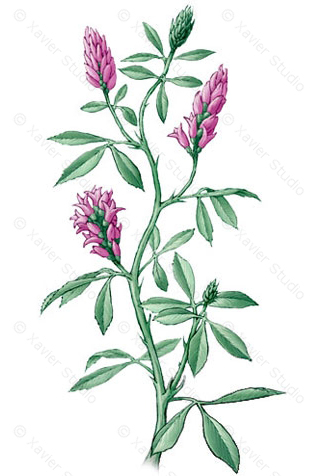 Alfalfa is helpful for chronic joint inflammation and aiding female hormonal balance. It comforts and strengthens the immune system. Alfalfa is rich in vitamins, minerals and other nutrients that play an important role in the maintenance of a healthy body. It contains protein, vitamin A, vitamin B1, vitamin B6, vitamin C, vitamin E, and vitamin K. It also contains calcium, potassium, carotene, iron and zinc and is considered one of the healthiest plant foods, providing an excellent range of nutritive properties for good health and well being.
Alfalfa is helpful for chronic joint inflammation and aiding female hormonal balance. It comforts and strengthens the immune system. Alfalfa is rich in vitamins, minerals and other nutrients that play an important role in the maintenance of a healthy body. It contains protein, vitamin A, vitamin B1, vitamin B6, vitamin C, vitamin E, and vitamin K. It also contains calcium, potassium, carotene, iron and zinc and is considered one of the healthiest plant foods, providing an excellent range of nutritive properties for good health and well being.
Interestingly, alfalfa is a treatment hay fever. Externally the seeds can be made into a poultice for boils, to soothe insect bites, and reduce inflammation. It alkalizes and detoxifies the body. Binds carcinogens in the colon to help speed up their elimination from the body.It is an overall tonic for general health, fatigue, weight gain, and debility. Alfalfa also stimulates the growth of supportive connective tissue, and is useful in the treatment of diabetes.
Alfalfa is a herb rich in protein and the vitamins A, D, E and K. The leaves contain eight of the essential amino acids.Such a a nutrient-rich formula, can be used to replenish the body with vitamins and minerals. It is specifically indicated for those with poor diets and inadequate nutrient intake.
Daily Dosages:
In addition to alfalfa sprouts found in most supermarkets, alfalfa is available as a dried leaf herb, in tablets, capsules, and powders.
- 2 to 3 cups tea
- 2 to 4 grams in capsules or pills 3 times a day
- 6 to 12 grams powder
- 3 ounces sprouts
To make tea, steep 1 tablespoon seed or 2 ounces dried leaf in 1 quart boiling water. In powder form, the pleasant taste of alfalfa is a welcome addition to soups and salads.
For high cholesterol: a typical dose is 5 to 10 grams of the herb, or as a steeped strained tea, three times a day. 5 to 10 mL of a liquid extract (1:1 in 25% alcohol) three times a day has also been used.
Herbal Combinations:
To get more natural vitamins, combine Alfafa with herbs such as Nettle and Rosehip, Nettle is high in both vitamin C and Iron, thus ensuring that energy levels and prevention of cellular damage is assisted. Nettles acts as a blood tonic with the ability to strengthen the body’s natural resistance. Rosehip is also extremely high in vitamin C and is one of the best herbs used for its antioxidant action on the body. It also assists with maintaining healthy collagen.
Cosmetic Uses:
Alfalfa extract (Medicago Sativum Extract) can be an antioxidant in skin-care products, it is said this extract is a great source of protein, minerals and vitamins C,D,E,K for the skin. Conditions and increases skin metabolism to promote skin healing,used as a topical skin conditioner.Alfalfa Extract is primarily used in manufacture of natural face masks and lotions. Saponins in alfalfa extract acts as natural foaming agent. Boots, Clarins and Lancome are using alfalfa extract in their skincare products. Continue reading
Rennie Luttrull: queen-annes-lace-seeds
Rosanna: Spignel aka Bald Money
Annamarie Squatrito: Fumitory
EILEEN Klinghagen: Pumpkin
Mahmudul Hasan: Celery

